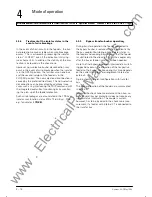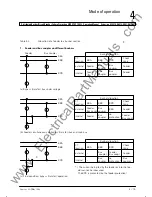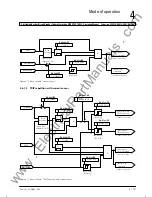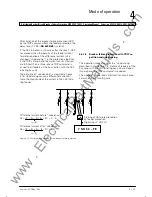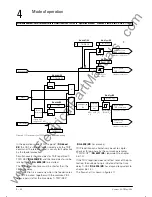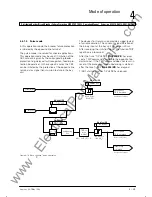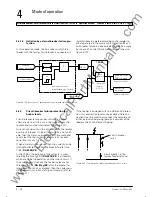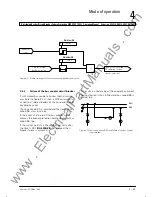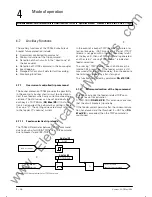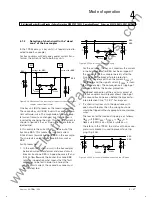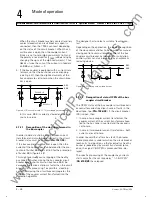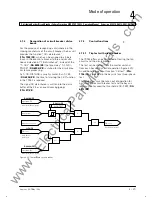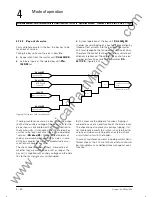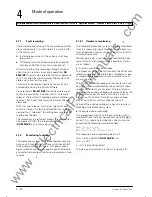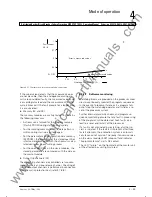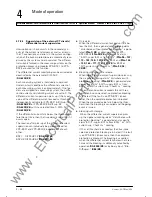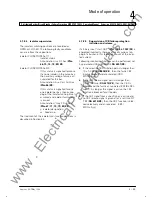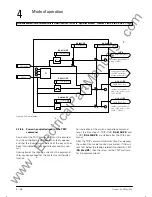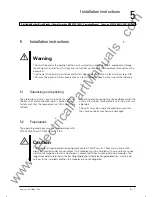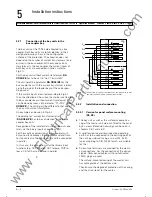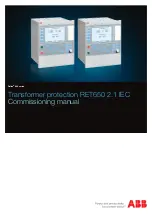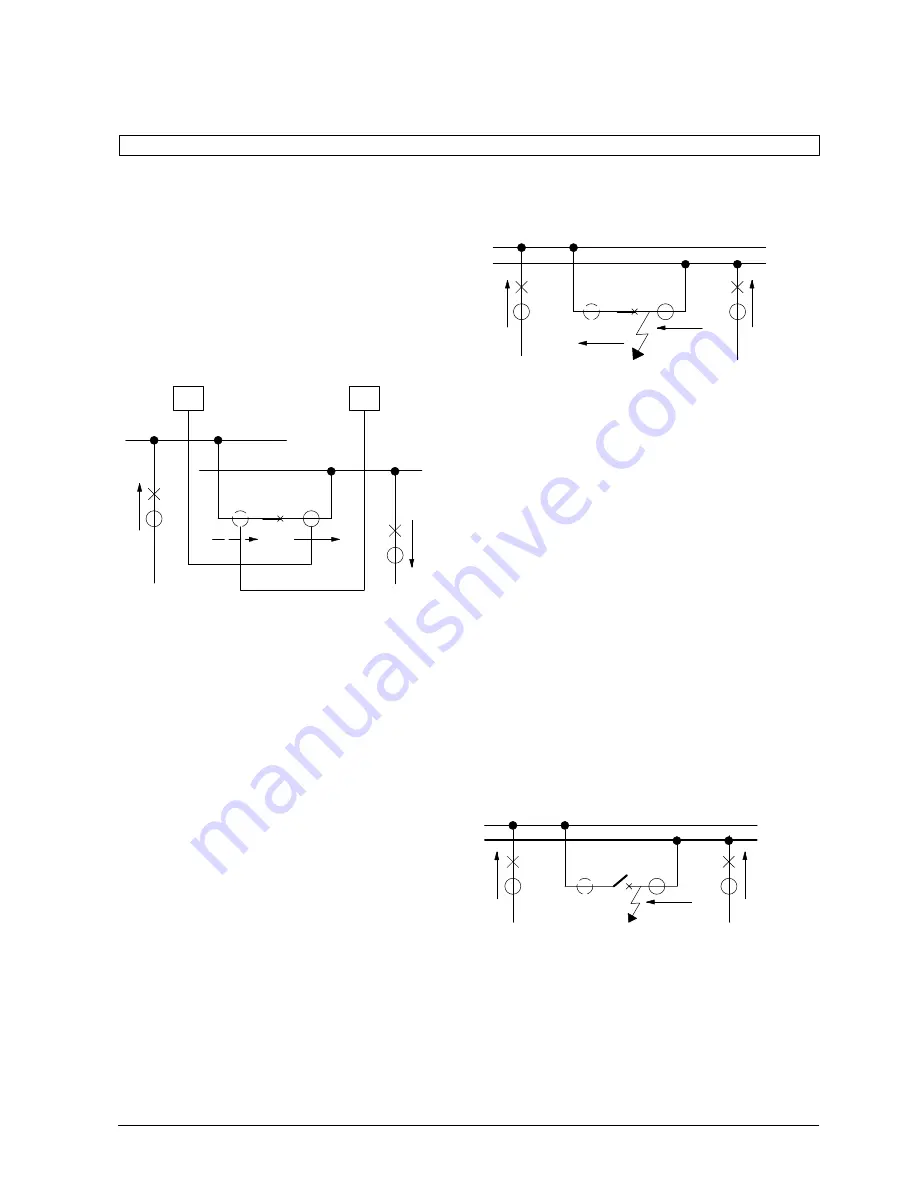
'(& )( )'& &) ( &!& ")& &$(( $#
Ć
%&( $# #)" &&#$
4 - 27
Siemens AG
⋅
May 1998
4.7.3
Detection of short-circuit in the "dead
zone" of the bus coupler
In the 7SS52 always 2 bay units (
^
2 feeders) are alloĆ
cated to one bus coupler.
For bus couplers with only one coupler current transĆ
former, the current is fed to both bay units.
BBB
BU2
BU1
CPBBB
CPBBA
current for BBB
current for BBA
2
1
BBA
Figure 4.24 Allocation of the bus coupler currents with onlyone bus
coupler current transformer
One bay unit (BU1 processes the measured current.
The second bay unit (BU2) inverts the connected curĆ
rent software-wise. The magnitude of the bus coupĆ
ler current remains unchanged, but the direction is
inverted by changing the sign. This inverted current is
shown in figure 4.24 as a virtual current transformer
(dotted line).
In this example the current
CPBBA
flows out of the
bus zone BBA. This means the inverted current
CPBBB
flows towards bus zone BBB in this example.
Thus no fault is seen for bus zone BBA as well as
BBB.
Fault processing:
1. In the event of a short-circuit in the bus coupler,
between current transformer and closed circuit
breaker, bus zone BBA is tripped, because
1
and
CPBBA
flow towards the busbar. Bus zone BBB
remains in operation what means that the fault
continues to be fed. In order to interrupt the
short-circuit current, the second bus zone must
be isolated, too.
BBA
BBB
2
1
CPBBA
CPBBB
Figure 4.25 Short-circuit in the dead zone
For this purpose, the bay unit monitors the current
in the bus coupler after BBA has been tripped. If
the current in the bus coupler persists after the
time delay of the breaker failure protection
"T-CBF" has elapsed, then the current
CPBBA
is
set to zero and the sign of current
CPBBB
is inverĆ
ted (unbalancing). The consequence is tripping of
bus zone BBB by the busbar protection.
Additional connection of the auxiliary contact of
the bus coupler circuit breaker allows tripping of
the second bus zone even before the breaker faiĆ
lure protection time "T-CBF" has elapsed.
2. If a short-circuit occurs in the dead zone with
open circuit breaker, then the wrong bus zone
would be tripped without appropriate countermeaĆ
sures.
The reason for the incorrect tripping is as follows:
BBA
=
(FEED)
BBA
-
CPBBA
³
BBA
> 0
BBB
=
(FEED)
BBB
+
CPBBB
³
BBB
= 0
Therefore, in the 7SS52, the status of the bus couĆ
pler circuit-breaker is used to prevent false tripĆ
ping. (Fig 4.26).
BBA
BBB
2
1
CPBBA
CPBBB
Figure 4.26 Short-circuit in the dead zone with the CB open
www
. ElectricalPartManuals
. com
Summary of Contents for SIPROTEC 7SS52
Page 1: ... w w w E l e c t r i c a l P a r t M a n u a l s c o m ...
Page 2: ...w w w E l e c t r i c a l P a r t M a n u a l s c o m ...
Page 3: ... Siemens AG 1998 w w w E l e c t r i c a l P a r t M a n u a l s c o m ...
Page 6: ... w w w E l e c t r i c a l P a r t M a n u a l s c o m ...
Page 17: ... w w w E l e c t r i c a l P a r t M a n u a l s c o m ...
Page 33: ... w w w E l e c t r i c a l P a r t M a n u a l s c o m ...
Page 34: ... w w w E l e c t r i c a l P a r t M a n u a l s c o m ...
Page 35: ... w w w E l e c t r i c a l P a r t M a n u a l s c o m ...
Page 36: ... w w w E l e c t r i c a l P a r t M a n u a l s c o m ...
Page 44: ... w w w E l e c t r i c a l P a r t M a n u a l s c o m ...
Page 166: ... w w w E l e c t r i c a l P a r t M a n u a l s c o m ...
Page 168: ... w w w E l e c t r i c a l P a r t M a n u a l s c o m ...
Page 170: ... w w w E l e c t r i c a l P a r t M a n u a l s c o m ...
Page 184: ... 1 w w w E l e c t r i c a l P a r t M a n u a l s c o m ...
Page 186: ... w w w E l e c t r i c a l P a r t M a n u a l s c o m ...
Page 202: ... 0 0 0 w w w E l e c t r i c a l P a r t M a n u a l s c o m ...
Page 206: ... X w w w E l e c t r i c a l P a r t M a n u a l s c o m ...
Page 208: ...w w w E l e c t r i c a l P a r t M a n u a l s c o m ...
Page 209: ...w w w E l e c t r i c a l P a r t M a n u a l s c o m ...
Page 210: ... w w w E l e c t r i c a l P a r t M a n u a l s c o m ...


